|
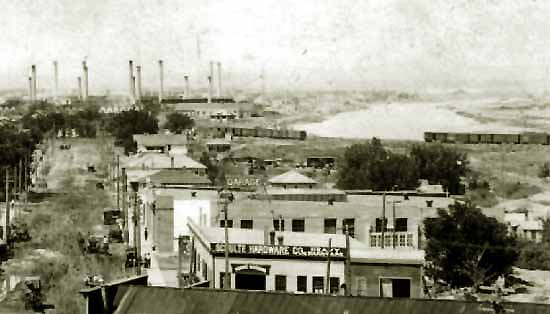
Casper, looking southwest toward Standard Refinery, approx 1920.
In center of photo are the Schulte Hardware workshops where, among other things, sheepwagons would be constructed.
In the distance can be seen the railway embankment constructed by the Burlington for its spur track to the
refinery. The embankment dried up the area behind Schulte's forming buildable land on the
Sandbar. To the right of Schulte's and the garage are the first of several cribs in the Sand Bar District.
[Writer's note: There is no uniformity as to whether the Sand Bar District of Casper should be spelled, "Sand Bar" or Sandbar.
Both are used.]
Before construction of the cribs, the "redlight" district of Casper was centered on David Street.
With the boom, oil riggers, teamsters, and other workers flocked to the city looking for the jobs offered by
the boom. They swarmed to Casper from as far away as Alaska and Texas. At night oil workers from Salt Creek, Old Lavoye and New Lavoye would, according to
Bob David, roam the downtown streets "roaring their challenges at all law and order and demanding whiskey and wild women."
Following the riggers were ladies of the evening who set up shops in
"cribs" in the Sand Bar District. The Sand Bar's first two buildings were the city's two
"pest houses" in which smallpox victims wwere quarantined. The Sand Bar provided cheap
land on which the cribs could be built.
Originally Casper was basically a cowtown. With the Oil Boom, because of the Sand Bar,
Casper acquired a world-wide reputation a a bit rough. Nick Maragos, discussed on the next page,
received a letter from Greece addressed to him only by his name and "Sand Bar, U.S.A." See Star-Tribune,March 28, 1982, p. 95.
Most of the cribs were little more than dilapidated shacks. Indeed, in 1920 a good furnished
shack in the Sand Bar could be purchased for as little as $100.00.
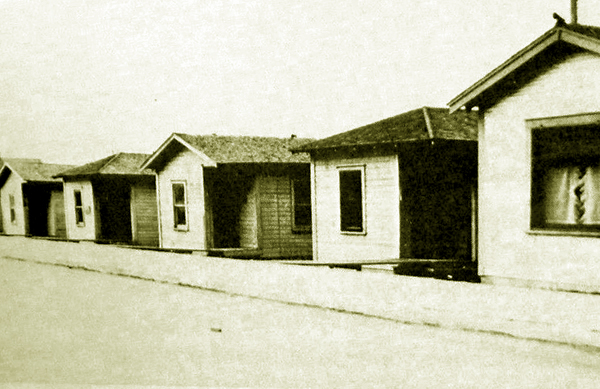
Casper, abandoned cribs on B Street, approx. 1924.
The influx to the Sand Bar began about 1916. Thus, there was also an influx of shootings, stabbings, robberies, and public drunkedness.
The Tribune would rant and rail against the conditions
in the Sand Bar. Typical was a November 4, 1918, front page editorial in which the paper wrote:
As a vivid and disgaceful reminder of the shame to which the city has been
lowered by the standards of the city administration, and the duty which lies before every Casper voter tomorrow, there is wafted up
from the notorious "Sandbar" district another stench that should call forth the
need of gas masks. The setting is the same -- a gambling hell and house of ill fame, and
the results came near chalking another fatal casualty against the system which permits such
dens to fourish."
Periodically, the police would promise a crackdown. Thus, in 1917, the police promised:
There will also be a stop put to loitering on the streets and spitting so that women fear to move
on certain sections of Center street. The police will take measures to prevent sidewalks being blocked.
"The Sand Bar will be one of the first places cleaned up." all loafers and persons who
cannot show that they have employment will be made to move. The sale of liquor and gambling in that
vicinity will not be permitted.
Nevertheless, the festivities contiinued. Some centered on the Star boarding house presided over by a
Mrs. Blair. Mrs. Blair kept a pet bear in her back yard. Pandemonium broke out when the bear got loose
and forceably attempted to enter the house. Altercations in the various houses were frequently reported.
In once instance according to the Tribune, August 21, 1918, J. Wilson "got into an
altercation with his lady love or someone else's lady love and pulled a gun. A passerby states that the
house looked like a bee hive after someone hit it with a rock
as there were fellows coming thru every window and door that led to the outer air."
There were also repeated problems with another lady known as the "Sand Bar Queen," Some of the problems related to the relationship
between the Queen and her "marital companion," an individual known as "Big Boy Cawley." Big Boy
on one occasion, referred to by the Record, as the "Chicken Party," complained to Justice of the Peace Tubb that he could have no 'privacy" in his home
"because there were alsways too many other men around." Casper Record, December 11, 1917. The search for
privacy created problems in the Cawley household. Big Boy was accused by the Queen of beating her up and
giving her a broken rib. The Sand Bar Queen explained to Justice Tubb,
You know judge, the whole thing started over my being ambitious to earn money. On Tuesday night, two of my
gentlemen friends came down to the rooming house, with one of their frinds, a little
giddy from heavy drinking. They were looking for a secluded spot don't cha know for him to sober up.
I had some fowls cooking on the stove, and they liked the odor. They asked that I make them
some chicken sandwiches. The man who was sobering up rented a room for me to serve his sandwiches in, and
your know, judge, I sold him five, a dollar a piece.
Well, this morning I had all of this money and "Big Boy" got peeved. He accused me of things that I haven't
done since I married him three months ago, and I became cross. Record, January 15, 1917.
Judge Tubbs ordered the two to leave town. Of course, they didn't. He also ordered Big Boy to stay out of
the Queen's house. The police crackdowns would not last long. Other incidents occurred because of
relationships between women and their paramours. In 1697, William Congreve wrote,
"Heaven has no rage like love to hatred turned, Nor hell a fury like a woman scorned." And it certainly was
true in Casper.
As oil riggers and laborers moved from camp to camp, they left behind in their wake women with whom they
had at one time professed love. Several of those women in their rage tracked the object of their fury to Casper.
In 1916 as a result of railroad construction, there had been an employment boom in Anchorage, Alaska. In 1917 with the end of the
boom in Anchorage, Lawrence
Barrett moved on to Casper. In Anchorage, he had courted Bessie Fisher and assisted her, according to a later statement by
Fisher in "squandering" $40,000 of her money. Perhap unknown to Miss Fisher, Barrett had a wife and child in Port Townsend,
Washington State. With the $40,000 nearly gone, Barrett told Miss Fisher to "Go to Hell," packed his bags, sold his possessions and proceeded
on to Wyoming where he apparently intended to open a drayage business serving the oil fields. After a month in Casper, he
sent for his wife and child in Washington State. The day after Mrs. Barrett arrived, Miss Fisher succeeded in tracking Barrett and appeared in Casper.
The Casper Record reported that Miss Fisher "forced" Barrett "to go to her room and then got him drunk." Mrs. Barrett had both
Fisher and her husband arrested. The Record reported, "When the police arrived Miss Fisher is said to have been
devoid of clothing." The paper did not report on the state of Barrett's attire. Miss Fisher was released from
police custody on the promise that she would leave town.
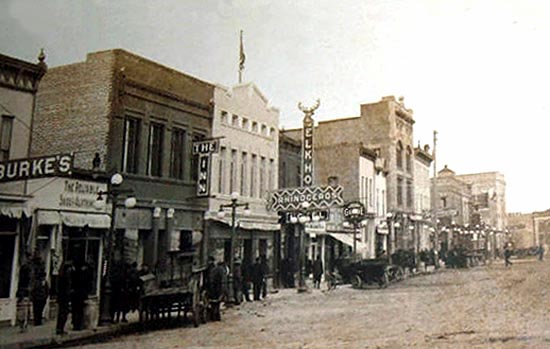
West side of the 100 Block of South Center St., approx. 1912.
Rhinoceros Restaurant to right of The Inn hotel and to the left of
the Elkhorn Saloon.
With Miss Fisher apparently out of the way, sweetness and light returned to the Barrett household. At noon, the day of
Miss Fisher's release, The Barretts were enjoying their noonday meal at the Rhinoceros Restaurant on South
Center Street. Why the restaurant would be called the Rhinoceros is probably unknown, but the term "rhino" was Cockney slang for a
thing of value perhaps derived from the Celtic roinn, a share, a division, and was used by
thieves to signify the part of spoil, booty, or plunder, to which they considered themselves entitled,
and then, by an extension of meaning, money generally. See McKay's 1887 Glossary of Obscure Words. A more speculative
derivation is given by Les expressions animalières en anglais, Presses Universitaries du Mirail, 2000, indicating that the term comes from the value of
rhinoceros horn as an aphrodisiac. As the Barretts were eating, Miss Fisher appeared in the restaurant and emptied one chamber of
her 38 caliber revolver into Barrett. Although Barrett was rushed to the Private Hospital at 840 South Durbin Street, he expired nine hours later as a result of his wounds.
The Casper Record quoted a taxi driver who claimed to have known Barrett in Anchorage as saying that Miss Fisher resided in the
"Red Light District" of Anchorage and that Barrett had never been intimate with Miss Fisher.
Nevertheless, the jury deadlocked, eleven votes not guilty and one vote holding out for guilty. Apparently, the jury believed that
it was self defense. Miss Fisher was not retried.
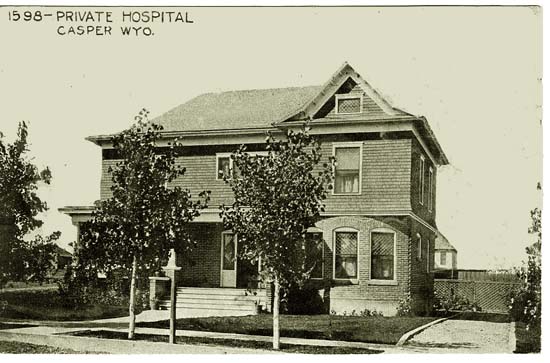
Private Hospital, Casper, 1919.
At the time, Casper had two hospials, the Private Hospital operated by Dr. H. R. Lathrup, as physician and surgeon in charge, and Natrona County Hospital. Both hospitals
opened in 1912. The opening of Natrona County Hospital, originally operated by the State as a part of the Wyoming General Hospital, provides a more interesting
view of the politics of the time. The county hospital was going to be located on property formerly owned by Judge Carey but dedicated for park purposes.
Before, however,
the paperwork relating to consent to use the park for the hospital, Judge Carey got into a snit about taxes. A letter
was received from one of Judge Carey's representatives, in the words of A. J. Mokler, expressing Judge Carey's
renging on consent to use the park:
"while Judge Carey was
willing to give some charitable organization a site for a hospital, he
would not, either directly or indirectly, donate a site to the town of
Casper, the county of Natrona, or the state of Wyoming. The reason he
would not give a site for the hospital was that he thought he had been
unjustly treated in the matter of taxation, and until that was righted
no favors might be expected from him."
An alternative site was purchased on East 2nd Street. The legislature appropriated funds for the
new hospital and it was completed and accepted by the State in 1910. The hospital then sat vacant, lacking any
equipment. In 1911, Judge Carey became governor, but, apparently, had not gotten over his snit. The legislature
apprpropriated funds for equipping the hospital. The appropriation bill was promptly vetos by
Governor Carey. The funds were finally sneaked into another appropriations bill which could not be vetoed without
great damage to the state. In October 1912, the County Hospital formally opened.
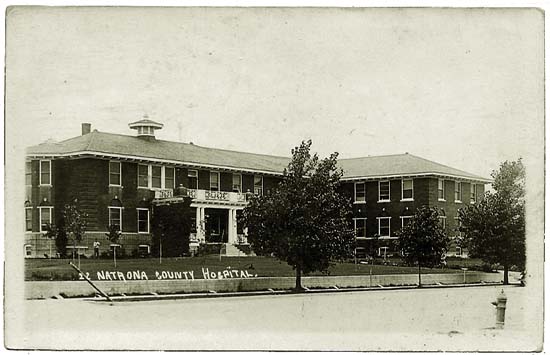
Natrona County Hospital, 1920's.
In so far as irate scorned girl friends were concerned, in 1921 it was déjà vu all over again.
John W. Delury was shot by Ida Graham, aslo known as Ida Durham, at a carnaval in the Sand Bar District.
Delury had left Graham in Oklahoma where he had
destroyed her furniture, curtains, and clothing. Graham tracked Delury to Casper where she did the evil deed with a 38 caliber revolver similar to that used by
Miss Fisher. Ida claimed that she had come to Casper after Oklahoma officials refused to prosecute Delury. In Casper she met with
newly appointed County Attorney Michael Purcell in his office on the third floor of the
Oil Exchange Building in order to get him to prosecute Delury. Purcell told her that he could not
prosecute someone for crimes committed in Oklahoma. Graham, referred to by the Tribune as a
"notorious" woman and as the "Barber of Burkburnett," claimed that as she was heading back to the
Burlington Station she passed the carnival. She heard Delury's voice. She confronted Delury. Graham claimed that she thought that
Delury was pulling a knife on her whereup she plugged him in self-defense.
Only this time, the jury convicted Graham. She was sentenced to twenty-one to twenty-two years in the Colorado Penitentiary.
After being released, Graham became a tent evangelist in the Port Arthur, Texas area and included within her messages
the need for prison reform.

The Wyoming Saloon, West side South Center Street, approx. 1912.
Intriguingly, in 1919 there was one night when things were quiet in the Sand Bar. At midnight, June 30, 1919, Wyoming went dry.
While large crowds were getting gloriously drunk in one last toot on Center Street, nothing was happening in
the Sand Bar. At the time, Center Street had some nine saloons along its short lenght. The Casper Daily Tribune noted,
Down in the Sandbar district where some of the uptown celebraters went in search of the wet goods late in the
evening, they found it as peaceful and quiet as a country graveyard. The wise ones then remembered the
raid staged by the county commissioners about a month ago and blamed
the county for the orderly conduct of this section of the city. Incidently the first
known natural death came last night when George Jones, a negro died of pneumonia in the district.
Meanwhile, on Center Street one cowboy, mounted on his horse, loped down Center Street several times as the crowds cried,
"Powder River, Let-er Buck."
With Prohibition, periodic raids were conducted in the Sand Bar. The seized booze was displayed by
law enforcement so as to prove they were on top of things.
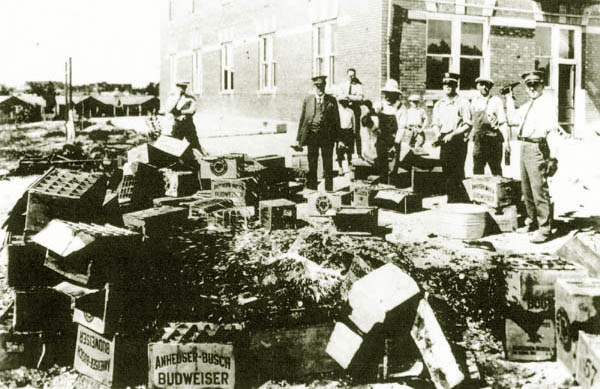
Seized booze, 1922.
Music this Page: "I Didn't Know the Gun Was Loaded" as sung by the Andrews Sisters for
Next page: the Sand Bar continued.
|